Blade Runner Blaster: Take Two
By Richard A. Coyle
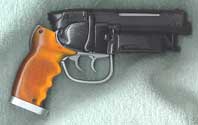 Not
long after I completed the first run of working Blasters and penned the ‘Making
of’ saga, Craig Kovach was writing and talking with me about the really
finer and nitpicking details of both my model and the real Blade Runner Blaster.
Craig had been doing some of his own homework, and after a tip from Phil Steinschneider,
he visited a nearby Planet Hollywood that had one of the stunt props in a display
case. He took as many pictures as possible to share and, aided with a very poor
sixth generation casting of one of the stunt castings and his own well-worn
copy of Blade Runner The Director’s Cut on DVD, kept grilling me relentlessly
on details.
Not
long after I completed the first run of working Blasters and penned the ‘Making
of’ saga, Craig Kovach was writing and talking with me about the really
finer and nitpicking details of both my model and the real Blade Runner Blaster.
Craig had been doing some of his own homework, and after a tip from Phil Steinschneider,
he visited a nearby Planet Hollywood that had one of the stunt props in a display
case. He took as many pictures as possible to share and, aided with a very poor
sixth generation casting of one of the stunt castings and his own well-worn
copy of Blade Runner The Director’s Cut on DVD, kept grilling me relentlessly
on details.
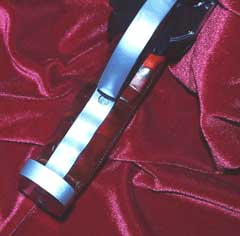 It’s
funny. You can watch a movie frame by frame a thousand times scrutinizing every
detail and still miss something obvious. I don’t know how many times I
have analyzed the Deckard’s-hand-through-the-wall sequence and never noticed
it. Craig called me up one night saying he had been doing the frame-by-frame
thing again and noticed something he had never seen before – a shadow that
looked a lot like a screw in the front of the pistol grip handle under the trigger
guard. Incredulous, I launched my laser disc and grabbed one of my stunt copies
as he spoke. There it was. I had missed it in the parting line! From the Planet
Hollywood photos and other stunt copies, he had
It’s
funny. You can watch a movie frame by frame a thousand times scrutinizing every
detail and still miss something obvious. I don’t know how many times I
have analyzed the Deckard’s-hand-through-the-wall sequence and never noticed
it. Craig called me up one night saying he had been doing the frame-by-frame
thing again and noticed something he had never seen before – a shadow that
looked a lot like a screw in the front of the pistol grip handle under the trigger
guard. Incredulous, I launched my laser disc and grabbed one of my stunt copies
as he spoke. There it was. I had missed it in the parting line! From the Planet
Hollywood photos and other stunt copies, he had 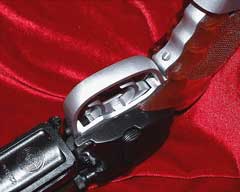 also noticed that I was using an Allen head cap screw where another flat head
slotted screw originally went into the back of the pistol frame. His urging
made me take the extra afford to find and use a variety of screws and thus make
all the fastener details as accurate as possible. All nitpicking aside, his
biggest contribution was in spotting the finer detail differences identifiable
in the earliest generation Steyr SL receivers relative to later versions. He
noted that the early model used smaller dot imprints for the on–off safety
indicators, and that the letter spacing was ever so slightly tighter on the
early Steyrs. Although the character font seems identical, the shape of the
letter "S" was decidedly different, too. Once he pointed it out these
subtle differences, I also noticed that the name stamping was also weaker on
the early runs, especially at the beginning of the word MANNLICHER, where the
letters M-A-N-N were not struck as deeply as were all the other letters –
perhaps a flaw in the original die. The chamfer on the ejector port was a touch
different as well. Details, details…
also noticed that I was using an Allen head cap screw where another flat head
slotted screw originally went into the back of the pistol frame. His urging
made me take the extra afford to find and use a variety of screws and thus make
all the fastener details as accurate as possible. All nitpicking aside, his
biggest contribution was in spotting the finer detail differences identifiable
in the earliest generation Steyr SL receivers relative to later versions. He
noted that the early model used smaller dot imprints for the on–off safety
indicators, and that the letter spacing was ever so slightly tighter on the
early Steyrs. Although the character font seems identical, the shape of the
letter "S" was decidedly different, too. Once he pointed it out these
subtle differences, I also noticed that the name stamping was also weaker on
the early runs, especially at the beginning of the word MANNLICHER, where the
letters M-A-N-N were not struck as deeply as were all the other letters –
perhaps a flaw in the original die. The chamfer on the ejector port was a touch
different as well. Details, details… 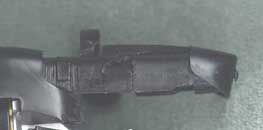
Well, my response to Craig was, "Either loan us the right
receiver so I can correct these so-minor-who’s gonna-ever-know details by spending a
zillion hours making new molds and masters for purity sake, or shut up!" He said
"Sure!" to loaning out the right receiver and only asked that I return cast
copies along with his original to help guide him with plastic test runs for his project to
machine the real Steyr receiver.
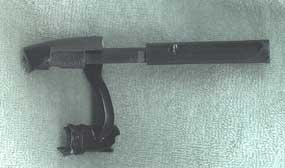 Craig
further challenged me to save the locking lugs. I told him there was NO WAY
– that the mold rubber would become caught and that there would be no way
to support the inner mold and…in the middle of going on about how it could
not be done, a light bulb went off and I saw a possibility! So I agreed to give
it a try, and sure enough, it worked! I cast his receiver with the locking lugs
intact and then cast the cocking lever with its locking lugs intact. Eureka!!
Bolt action perfection.
Craig
further challenged me to save the locking lugs. I told him there was NO WAY
– that the mold rubber would become caught and that there would be no way
to support the inner mold and…in the middle of going on about how it could
not be done, a light bulb went off and I saw a possibility! So I agreed to give
it a try, and sure enough, it worked! I cast his receiver with the locking lugs
intact and then cast the cocking lever with its locking lugs intact. Eureka!!
Bolt action perfection.
Now I could kill two birds with one stone: I could make the
cocking lever even more accurate and actually lock into the receiver, while
at the same time I could simplify all that time spent to machine a metal sleeve
to mount the cocking arm. So I re-machined the new receiver castings; re-worked
the bolt and fitted the new casting of the lugged cocking lever to it; and machined
the new bolt and lever assembly to clear the Bulldog frame. Finally, I re-worked
the end cap to help eliminate a weakness of the first model and to help hold
the cocking lever onto the bolt.









